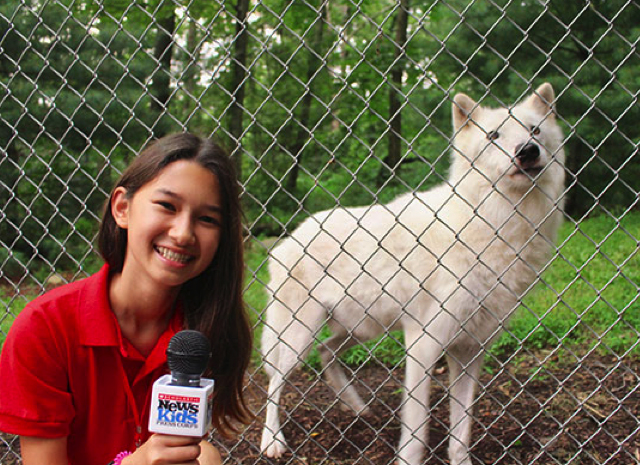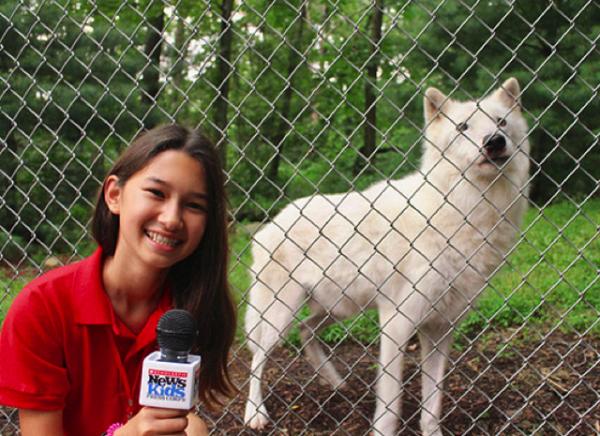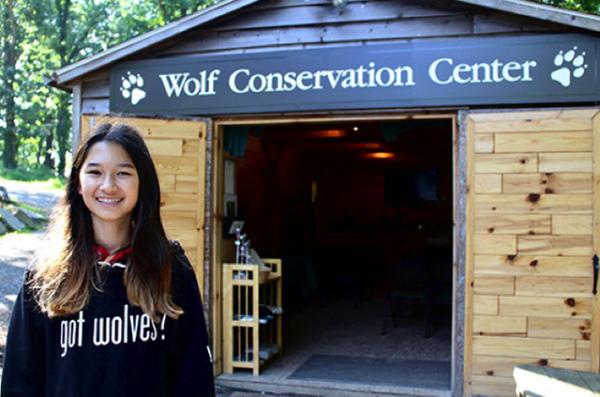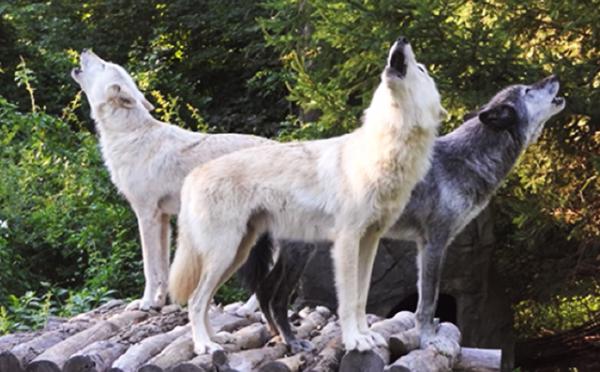KID REPORTERS’ NOTEBOOK
Sleeping With the Wolves

WATCH THE VIDEO
Click below to learn more about Ava’s visit to the Wolf Conservation Center.
Imagine that you’re sleeping in the wilderness in a tent and are awakened by the sound of wolves howling. That’s what happened to me last summer when my family and I spent the night at the Wolf Conservation Center (WCC) in South Salem, New York.
The howling didn’t scare me. It didn’t frighten Lilah Hapsom, either. “I’m not afraid,” the eight-year-old said. “They look just like my dog.”
Wolves are actually shy animals that tend to stay away from people. It is only a myth that wolves howl at the moon. They howl to communicate with each other. Since they are nocturnal (most active at night), the howling tends to happen when the moon is shining.

Ava with Atka, an Arctic wolf, at the Wolf Conservation Center in South Salem
A COMEBACK IN THE WILD
The WCC educates people about wolves, their relationship to the environment, and how to ensure that they survive. Guests are invited to visit the wolves year-round. During the summer and fall, visitors can sign up to spend the night in tents, which is what my family and I did.
The center is home to 25 wolves and 2 critically endangered species—the red wolf and the Mexican gray wolf. At one point, both species were extinct in the wild. With help from the WCC’s “breed and release” efforts, the wolves are making a comeback.

Ava gets ready to learn more about wolves and the threats they face. (Photo courtesy of the Wolf Conservation Center)
WHY WOLVES MATTER
Throughout history, wolves have been poisoned and shot to clear land for farming and housing. They also have been hunted because people are afraid of them.
Even stories about the Big Bad Wolf in The Three Little Pigs and Little Red Riding Hood have caused fear. “I learned that all dogs are 98 percent wolf, even a poodle,” said WCC visitor David Reilly, 10. “People shouldn’t kill wolves.”

Three Canadian gray wolves, Zephyr, Alawa, and Nikai, howl. (Photo courtesy of the Wolf Conservation Center)
“KIDS ARE GREAT EDUCATORS”
About 50 years ago, wolves were on a path to extinction in the United States, Europe, and Asia. This would have wreaked havoc on ecosystems.
“Wolves help to keep all other animals in balance and keep the environment really healthy,” said Mary Kate Kabbes, an educator at the WCC.
When wolves became extinct in Yellowstone National Park, the elk population increased to five times its normal size and demolished areas where birds nested. As a result, several bird species were eliminated in the park.
Now that wolves are back at Yellowstone, the birds have returned. “Learning about wolves, reading books about them, and telling your parents, friends, and family is a simple way to help spread the word [about the importance of wolves],” Kabbes said. “Kids are great educators.”
Raising awareness about wolves will help with the survival of the species. For now, wolves are still on the endangered species list.
